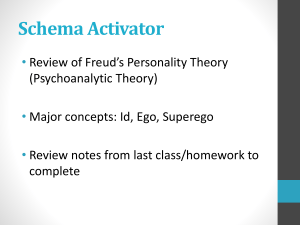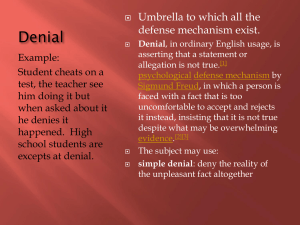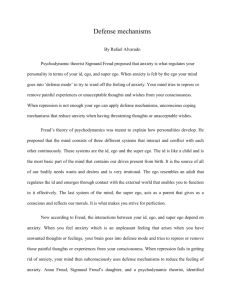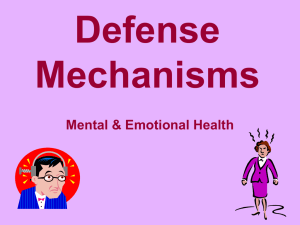Ego Defense Mechanisms - Everyday Health & Wellness Therapy
advertisement
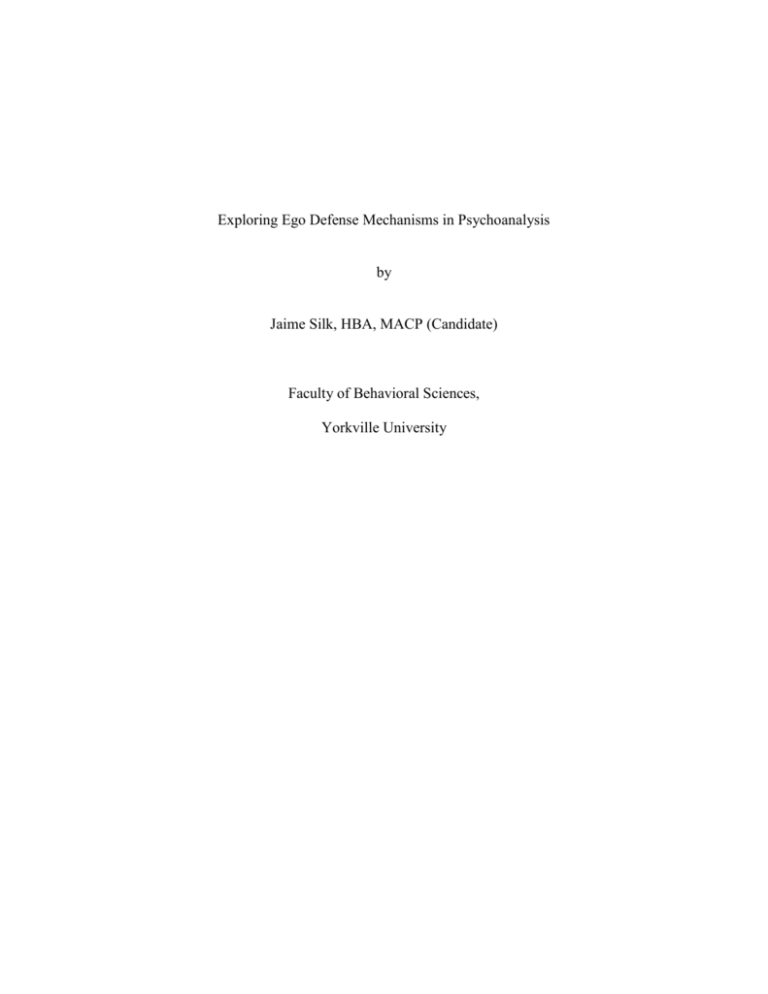
Exploring Ego Defense Mechanisms in Psychoanalysis by Jaime Silk, HBA, MACP (Candidate) Faculty of Behavioral Sciences, Yorkville University “Being entirely honest with oneself is a good exercise” -Sigmund FreudSigmund Freud is one of the grandfathers of the psychological discipline and arguably the best known psychologist to date. Freud introduced the train of thought that human behaviour and thought exists on deeper and more convulsed levels. More specifically Freud exposed the influences of the unconscious and how it affects the way we live and the things we do. Over one hundred years ago was when Freud gave way to the underworld of thoughts, feelings and desires, such that, he claimed much of what we see is not the majority of our mental activity (Corsini & Wedding, 2008). In an extension of Freud’s original theories and applications of those theories, this discussion intends to take an in depth look at ego defense mechanisms. What ego defense mechanisms are will be explored through historic accounts and contemporary research to formulate a conclusion on how their presence can be applied to clinical work to date. The discussion will begin with the origins of the research of defense mechanisms; proceed to discuss the development of them across findings and time; and finally, our dialogue will conclude with the practical applications of specific intervention techniques. “The term ‘defence’…is the earliest representative of the dynamic standpoint in psychoanalytic theory” (Corsini & Wedding, 2008, pg. 17). Defense mechanisms are automatic responses to situations that trigger an unconscious processing of fear or what is referred to as ‘psychic danger’ (Corsini & Wedding, 2008). The functionality of defense mechanisms is to defend oneself from a situation that is triggered as emotionally or cognitively unbearable, making it bearable through these varieties of protective mechanisms; it is the ego’s struggle against agonizing ideas (Corsini & Wedding, 2008). Before exploring the theoretical and philosophical underpinnings of defense mechanisms, a few examples of these defenses will be named and defined through the explanations offered by Corsini and Wedding (2008). Additionally, an example of how a person or client may exercise the use of the particular defense will be provided. There are numerous examples of defense mechanisms, but for the sake of concision in the length of this discussion only a few basic examples will be offered. One of the common defenses is denial. This is the process of rejecting what is true in reality as a result of it being too painful to accept. It is known to be clinical populations struggling with addictions because facing the reality of the addiction may reveal the severity of it which would require quitting the addiction. This thought would be very painful for an addict and therefore, the use of denial protects the person from this ‘dangerous’ thought. Another common defense is avoidance. This defense is more common than denial and is the process of someone withdrawing in order to avoid anxiety or pain of a situation or relationship. Clients living with anxiety often exercise this defense as engaging with particular situations or people facilitates such intense anxiety. Projection is the process of attributing one’s own feelings onto someone else. This defense has been found to be common with people with Borderline Personality Disorder (BPD) and is the main defense of those with paranoia. If someone is feeling extremely scared in a situation but do not want to appear as such, they may turn to the person they are with and say “this must be way too scary for you, let’s leave”. Repression is the defense that attempts to remove painful memories from the conscious mind. This defense aims to repress the memories somewhere in the unconscious so it is inaccessible to the individual with the memory. This defense is common for those who live through traumatic experiences. For example, someone who experiences sexual abuse in their childhood may repress the traumatic memories they endured in order to try to cope with their life. The last defense mechanism that will be outlined before we move on to attitudes and research concerning the concepts of defense mechanisms is obsessional thinking and compulsive rituals. These defenses are explained together as both aims to reduce anxiety by either a shift in thinking or reduction through behaviour. These defenses aim to protect the psyche from unbearable feelings or unacceptable thoughts. Obsessional thinking shifts from inappropriate thoughts to fixated details of another topic in order to execute cognitive control. Compulsive rituals have a similar purpose but reduce anxiety through repetitive behaviours. A client having obsessive thought patterns towards harming someone in their life may shift their thoughts onto something totally unrelated but controllable to exercise cognitive control. An example may be shifting obsessive thinking towards food behaviours then the cognitive stress and behavioural rituals are channelled into eating patterns. Now that a few specific defense mechanisms have been outlined and exemplified. Let’s explore the beliefs, attitude and underpinnings of these defenses generally and specifically. In early research Freud outlined defense mechanisms and their functioning’s, however, conclusive research was not available to demonstrate their validity. Current research has explored a number of avenues in the way in which how ego defense mechanisms operate in a variety of population groups and furthermore, the predictive nature of them. Domino and colleagues (2002) explored the connection between 15 operationally defied ego defense mechanisms and measures of creativity in sample of college students and found that the students that were highly creative scored significantly higher on particular ego defenses than the low creative student group. Through the use of videotaped semistructured interviewing techniques the use of ego defenses were scored in both population groups. The creative students scored higher on measures of schizoid fantasy, disassociation, reaction formation, humour, intellectualization, and sublimination. The low creative student group scored significantly higher on the defences of projection, passive aggressiveness, repression and altruism. Researchers highlight that population group being young adults may mean that results are not completely generalized due to this stage of development possible exerting defense styles associated with adaptation. However, the research is still supported that certain personality factors and creative abilities are associated with particular defense mechanisms. Parekh and colleagues (2011) conducted a study exploring ego defense mechanisms which was published in the European Journal of psychiatry. It explored the presence of ego defense mechanisms in a population under a higher level of stress than average person. They evaluated a group of medical students from Pakistan in order to understand the prevalence of various ego defense mechanisms. The study provides the theoretical background explaining that defense mechanisms are “unconscious resources used by the ego to reduce conflict between the id and the superego” (Parekh, et al., 2011, p.1945) It further comments on how they are a way in which people cope with stress. Using the Defense Style Questionnaire (DSQ-40) 682 students were individually assessed and group under one of three major categories of defences. The three categories were measured as Mature, Immature and Neurotic factors. The Mature factors were concluded by a collection of researchers to result in better coping and adaptation skills leading to optimal health and functioning. The study concluded that Neurotic factors were the most prevalent of ego defenses present. Mature factors were more prevalent in public school students then there private school counter parts. Males demonstrated higher levels of Immature defense mechanisms than females; females showed more neurotic tendencies than males. Additionally, females in private medical schools, more specifically in their first two years, presented higher levels of neurotic ego defense mechanisms. In conclusion, the presence of ego defence mechanisms is believed to increase in more stressful circumstances. The implications of these findings build on the theoretical concepts of the ego attempting to manage the conflict of the id and superego; an increase of conflict may produce an increasing demand for defense. Pellitteri (2002) conducted a study looking at how ego defense mechanisms and emotional intelligence are related. Using the hierarchical model of defense mechanisms developed by Bond and colleagues (1993) Pellitteri (2002) conducted a bivariate correlation analysis which yielded mixed results. The study found that adaptive defense styles were correlated overall with higher levels of emotional intelligence, however, not specifically with emotional perception and regulation which was hypothesized. Secondly, the hypothesis of general intelligence being correlated with emotional knowledge and both adaptive and maladaptive defenses was supported. The conclusions involved addressing what research continuously finds on our topic at hand, which is that ego defense mechanisms are related to psychological adaptation. Cramer (1999) investigates ego development and the two functions of ego defence mechanisms and intelligence in his interesting study published in the Journal of Personality in the October, 1999 edition. Using 89 students, Cramer (1999) found that intelligence and ego defences were not related, however, both factors predicted ego level. The relationship with intelligence quotient (IQ) scores and ego level was linear; the relation with the use of defense was curvilinear. At low levels of IQ stronger levels of denial and projection were associated with higher ego levels. At high IQ levels, high use of denial was associated with low ego levels. Higher use of projection was associated with higher ego levels. This study conducted by Cramer (1999) brings forth some interesting implications. First, the fact that people who are found to measure for higher ego use projection defenses can be logically to understanding that they think that the way they feel is (arguably) more important and furthermore ‘the right way to feel’. A bigger measure of ego is associated with an individual believing that their thoughts and feelings are universal because they are ‘correct’. The fact that ego defence mechanisms are not unilateral but rather bidirectional becomes apparent through his results. The use of a defense mechanism in one client may be present for the direct opposite purpose of another client. In this situation, denial was being used by individuals scoring lower on IQ measures to protect the reality that are not (statistically measured) as overly intelligent. The findings imply that these participants execute the use of denial to protect from the reality of being or feeling like they lack in the area of IQ. Alternatively, participants who scored high on IQ but denial was still present, implies that the use of denial here is for the opposite purpose; it is used to deny their superior intelligence levels relative to the average population. This concept will be further discussed as we now bridge our conversation from current findings to clinical implications. Contemporary research clearly indicates that theoretical concepts of ego defense mechanisms can be operationally defied, measured and reliably found to be related to a number of psychological factors. Differences in culture, gender, profession, education levels and many other psycho-sociological factors can be found consistently supporting the theoretical basis for ego defense mechanisms and how they serve to function as coping mechanisms and are tools for psychological protection and adaptation. Now that the research, attitudes and philosophies of defense mechanisms have been explored in depth, let’s switch gears to take a practical look about how they can be used clinically. Therapeutic applications of defense mechanisms can be highly beneficial but require knowledge, understanding and ethical considerations. Corsini and Wedding (2008) highlight the importance of the therapist respecting the “content behind the ‘fence’ of the defense” (pg.33). This requires special care and consideration because it is the ethical responsibility of the therapist to not induce harm to the client. If the therapist did not approach the content that the defense mechanism was hiding with therapeutic knowledge and caution the client could react in a number of undesired ways. Pellitteri’s (2002) study that was previously outlined in our dialogue concluded his research with clinical implications and psychoeducational interventions of ego defense mechanisms. He integrated a study conducted by Mayer and Salovey (1995) which addressed the need to work with defense mechanisms on the level of awareness presented by the client. It is explained that a client may have conscious access and awareness of their defense mechanisms which would allow for easier discussion and management of the emotions the client in aiming to protect. This would also make the ability to execute more practical intervention strategies possible. Alternatively, if the source of the client’s defense is unconscious to the client, a more through and psychodynamic approach to tapping into those unconscious processes would be more effective. Pellitteri (2002) also highlights the need for psychoeducational awareness of how ego defense mechanisms work in order to facilitate deeper understanding of how we utilize our ability to psychologically adapt and continue to build on our emotional intelligence. The study conducted by Cramer (1999) that was also earlier discussed highlights the clinical importance of understanding that defense mechanisms are not necessarily static in the way the function. It is important when working with clients the particular defense that is being observed must be considered how it is being executed. Although some of the thoughts I am about to present may not be in complete alignment with Freud’s precise explanation of a few particular defense mechanisms, I would like to expand the theory to the practice here to entertain a few ideas about clinical observation of defense mechanisms. Freud explains – as earlier defied – projection when “the patient attributes unacceptable impulses or feelings of his own onto another person or agency” (Corsini & Wedding, 2008, p.33). Is it possible to explore the equal but opposite nature of this defense mechanism? For example, with projection, it may not always be the case that a client is projecting negative emotions. Can positive emotions be projected in fear of the alternative? This seems theoretically congruent. In a counselling session with a teenager and their parent, what appears to be projection could be observed, such that, parents project their feelings of love and acceptance towards their child assuming that their child feels the same. I observe this as projection not only because the parent may not understand or connect with the fact that their child could feel differently than them, but additionally, a parent would have to accept that their child does not necessary love and accept themselves which would then require the parent to ‘admit’ or potentially internalize they have not done their job as a parent. This idea of positive projection serving as defense would simply be an expansion of thought toward some of the ways in which the defenses are defied. Another clinical implication that could expand from the previous scenario discussed is that a parent could simultaneously be executing denial that their child does not accept themselves. In theoretical circumstances the isolation of variables in essential to their understanding; however, when it comes to practice of understanding the clinical basis of defense mechanisms the fact that they are potentially not mutually exclusive but rather highly convoluted is something that a therapist should take into account. Right from the fundamental outlines of ego defense mechanisms they have played a strong role in theory and practice of human behaviour. Exploring the theoretical basis of ego defenses; highlighting a few clinical implications; and, lastly raising a few questions concerning the inclusivity of their definitions has been an enlightening journey. “Most men would rather deny a great truth than face it” -George Martin- References Corsini, R. J. & Wedding, D. (2008). Current Psychotherapies. Eighth Edition, Thompson Brooks/Cole Cramer, P. (1992). Ego Functions and Ego Development: Defense Mechanisms and Intelligence as Predictors of Ego Level. Journal of Personality, 67 (5), 735-760 Domino, G., Short, J., Evans, A., & Romano, P. (2002). Creativity and Ego Defense Mechanisms; Some Exploratory Empirical Evidence. Creativity Research Journal, 14 (1), 17-25 Mayer, J., D., & Salovey, P. (1997). Emotional intelligence and the construction and regulation of feelings. Applied and Preventative Psychology, 4, 197-208 Parekh, M., Majeed, H., Khan, T., Khan, A., Khalid, S., Khwaja, N., Khalid, R., Khan, M., Rizqui, I. Jehan, I. (2011). Ego defense mechanisms in Pakistani medical students: a cross sectional analysis. European Psychiatry, 26, 1945-1946 Pellitteri, J., (2002). The Relationship between Emotional Intelligence and Ego Defense Mechanisms. Journal of Psychology, 136, 182

